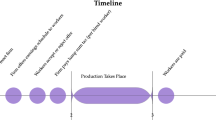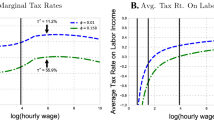Abstract
We extend Stiglitz (J Public Econ, 17, 213–240,1982) to a dynamic and stochastic optimal taxation model, while assessing the effects of exogenous wage regulations. We show that when wage regulations are imposed, consumption inequality rises more than when they are removed. The results lead to an important policy implication that in the face of exogenous wage regulations, the social planner who can design optimal tax schedule prefers to widen the consumption inequality. From this perspective, the drive to enhance production efficiency outweighs the motivation for redistribution. A conventional wisdom that full employment commitment and minimum wage legislation should serve as a buffer for the minority may not be taken for granted. In the qualitative analysis, we find that as wage regulations tighten, the lower bound of the marginal tax rate on capital rises. Our quantitative result validates that, showing that the marginal tax rate on capital increases to varying degrees in response to wage requirements of varying tightness.

Similar content being viewed by others
Notes
Prior to the literature NDPF, some papers discussed a related issue. For example, Atkinson and Stiglitz (1976) investigate differentiated commodity taxation, in which consumption at different points in time can be viewed as different commodities.
References
Ales, L., Kurnaz, M., & Sleet, C. (2015). Technical change, wage inequality, and taxes. American Economic Review, 105, 3061–3101.
Allen, S. (1987). Taxes, redistribution, and the minimum wage: A theoretical analysis. Quarterly Journal of Economics, 102, 477–489.
Atkinson, A., & Stiglitz, J. (1976). The design of tax structure: Direct versus indirect taxation. Journal of Public Economics, 6, 55–75.
Autor, D., & Dorn, D. (2013). The growth of low-skill service jobs and the polarization of the US labor market. American Economic Review, 10, 1553–1597.
Autor, D. (2014). Skills, education, and the rise of earnings inequality among the other 99 percent. Science, 344, 843–851.
Bezes, P., Fimreite, A., Lidec, P., & Lægreid, P. (2013). Understanding organizational reforms in the modern state: Specialization and integration in Norway and France. Governance, 26, 147–175.
Brown, C., Gilroy, C., & Kohen, A. (1982), The effect of the minimum wage on employment and unemployment: A survey. National Bureau of Economic Research.
Dube, A., Lester, T., & Reich, M. (2010). Minimum wage effects across state borders: Estimates using contiguous counties. Review of Economics and Statistics, 92, 945–964.
Dustmann, C., Lindner, A., Schönberg, U., Umkehrer, M., & Vom Berge, P. (2022). Reallocation effects of the minimum wage. Quarterly Journal of Economics, 137, 267–328.
Fortin, N. (2006). Higher-education policies and the college wage premium: Cross-state evidence from the 1990s. American Economic Review, 96, 959–987.
Golosov, M., Kocherlakota, N., & Tsyvinski, A. (2003). Optimal indirect and capital taxation. Review of Economic Studies, 70, 569–587.
Golosov, M., Tsyvinski, A., & Werning, I. (2006). New dynamic public finance: A user’s guide. NBER Macroeconomics Annual, 21, 317–387.
Hungerbühler, M., & Lehmann, E. (2009). On the optimality of a minimum wage: New insights from optimal tax theory. Journal of Public Economics, 93, 464–481.
Kettl, D. (2006). Is the worst yet to come? Annals of the American Academy of Political and Social Science, 604, 273–287.
Kocherlakota, N. (2010). The new dynamic public finance. Princeton University Press.
Kocherlakota, N. (2005). Zero expected wealth taxes: A mirrlees approach to dynamic optimal taxation. Econometrica, 73, 1587–1621.
Krusell, P., Ohanian, L., Ríos‐Rull, J., & Violante, G. (2000). Capital‐skill complementarity and inequality: A macroeconomic analysis. Econometrica, 68, 1029–1053.
Lavecchia, A. (2020). Minimum wage policy with optimal taxes and unemployment. Journal of Public Economics, 190, 104228.
Lee, D., & Saez, E. (2012). Optimal minimum wage policy in competitive labor markets. Journal of Public Economics, 96, 739–749.
Mirrlees, J. (1971). An exploration in the theory of optimum income taxtion. Review of Economic Studies, 38, 175–208.
Neumark, D., Schweitzer, M., & Wascher, W. (2004). Minimum wage effects throughout the wage distribution. Journal of Human Resources, 39, 425–450.
Guesnerie, R., & Roberts, K. (1987). Minimum wage legislation as a second best policy. European Economic Review, 31, 490–498.
Rothschild, C., & Scheuer, F. (2013). Redistributive taxation in the Roy model. Quarterly Journal of Economics, 128, 623–668.
Scott, I., & Gong, T. (2021). Coordinating government silos: Challenges and opportunities. Global Public Policy and Governance, 1, 20–38.
Stiglitz, J. E. (1982). Self-selection and pareto efficient taxation. Journal of Public Economics, 17, 213–240.
Thuemmel, U. (2023). Optimal taxation of robots. Journal of the European Economic Association, 21, 1154–1190.
Tsai, Y., Yang, C., & Yu, H. (2022). Rising skill premium and the dynamics of optimal capital and labor taxation. Quantitative Economics, 13, 1061–1099.
Acknowledgement
Financial support from the Ministry of Science and Technology (MOST 111-2410-H-415-026) is gratefully acknowledged. I thank an anonymous referee and the editor for helpful comments. All remaining errors are my own.
Funding
Funding was provided by Ministry of Science and Technology, Taiwan (Grant No. 111-2410-H-415-026).
Author information
Authors and Affiliations
Corresponding author
Additional information
Publisher's Note
Springer Nature remains neutral with regard to jurisdictional claims in published maps and institutional affiliations.
Rights and permissions
Springer Nature or its licensor (e.g. a society or other partner) holds exclusive rights to this article under a publishing agreement with the author(s) or other rightsholder(s); author self-archiving of the accepted manuscript version of this article is solely governed by the terms of such publishing agreement and applicable law.
About this article
Cite this article
Chen, Y. Optimal dynamic nonlinear income taxation with wage regulations. Int Tax Public Finance (2023). https://doi.org/10.1007/s10797-023-09789-7
Accepted:
Published:
DOI: https://doi.org/10.1007/s10797-023-09789-7




